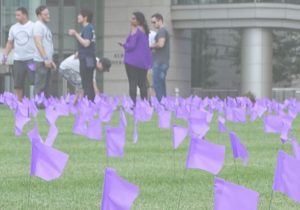Sep
04

Posted by Susan Halpin on September 4th, 2020
Posted in: Blog, NLM Resources, Public Health
Tags: Addiction, drug addiction, International Overdose Awareness Day, National Recovery Month, opioid addiction, recovery, substance use disorder, SUD

Structure and community connection are two key elements that most individuals challenged with substance use disorder rely on to maintain their recovery. COVID-19 and the physical distancing and quarantine measures required to prevent the virus from spreading, has contributed to a spike in the number of overdoses from opioids during the last 6 months.
Recent data from around the U.S. confirms that drug overdoses are rising by roughly 18% during the coronavirus pandemic. ODMAP – the Overdose Detection Mapping Application Program (http://www.odmap.org/), located at the University of Baltimore, is also reporting a significant spike in the number of fatal overdoses. The ODMAP tool provides near real-time suspected overdose surveillance data across jurisdictions to support public safety and public health efforts to mobilize an immediate response to a sudden increase, or spike in overdose events. ODAP compared reported overdoses, both fatal and nonfatal in the weeks right before quarantine measures were implemented and in the weeks after. More than 60% of counties participating in the information-gathering project reported increases in drug overdoses.
There is also another factor besides COVID-19 contributing to the increase in overdoses, street drugs are even more dangerous now because more dealers are lacing their drugs with the synthetic opioid, fentanyl.
“The nation needs to confront the fact that the nation’s drug overdose epidemic is now being driven predominantly by highly potent illicit fentanyl, heroin, methamphetamine and cocaine, although mortality involving prescription opioids remains a top concern,” said AMA Opioid Task Force Chair Patrice A. Harris, M.D., M.A., who also is the AMA’s immediate past president. “If it weren’t for naloxone, there likely would be tens of thousands additional deaths. It is past time for policymakers, health insurers, pharmacy chains and pharmacy benefit managers to remove barriers to evidence-based care for patients with pain and those with a substance use disorder.”
August 31st was International Overdose Awareness Day — IOAD. This global campaign began in Melbourne, Australia in 2001. Last year 874 events took place in 39 countries. This year was the 20th anniversary year. IOAD aims to raise awareness of overdose and reduce the stigma of drug-related deaths. It is also an opportunity to stimulate discussion around evidence-based overdose prevention and drug policy. IOAD acknowledges the grief felt by families and friends whose loved ones have died or suffered permanent injury from a drug overdose. It spreads the message about the tragedy of drug overdose death and that drug overdose is preventable.
The goals of International Overdose Awareness Day are:
Even though we are in difficult and uncertain times, there is good news. Many people do recover from substance disorder. The American Medical Association’s Opioid Task Force report released in July of 2020 did contain information about positive changes in the prescribing of opioids and in the care those with substance use disorder are receiving. The following are some key points from the report.
September has been recognized as National Recovery Month every year for past 31 years, SAMHSA (Substance Abuse and Mental Health Services Administration) and other organizations involved with the prevention and treatment of substance use disorder take part in celebrating the gains made by those living in recovery through the national observance of National Recovery Month. Educating Americans that substance use treatment and mental health services can enable those with mental and substance use disorder to live healthy and rewarding lives. SAMHSA has a series of webinars related to recovery that you can attend throughout the month of September. For more information see the SAMHSA recovery month webpage https://www.recoverymonth.gov/.
The following websites, articles and resources are related to substance use disorder and may be of interest: